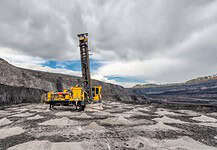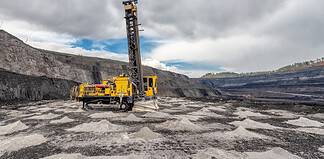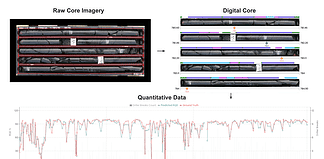KIRKLAND Lake Gold’s Fosterville gold mine in Bendigo, Victoria, has been at the vanguard of Victoria’s resurgent gold industry since the discovery of the Eagle zone in 2015.
With production for 2018 reaching 356,230oz, and Q1 of 2019 recorded as the most successful quarter of the mine’s history, Fosterville has established itself as a heavy-hitter outside of the WA dominated gold sector, and one of the country’s most profitable mines.
Victoria’s waning gold industry was kick-started when, in 2015, Kirkland Lake discovered exceptionally high-grade gold from deep drilling bellow the Fosterville mine near Bendigo.
Since the discovery of the Eagle zone, which contained high-grade visible-gold bearing mineralisation, the mine has improved its overall mineral reserve grade significantly.
In 2016, the company explored similar visible-gold bearing zones at depth in the Harrier zone and after additional exploration progress in early 2017, a new mineral reserve and mineral resource estimate was released on June 30, 2017, which more than doubled the underground reserve to 1.03moz, and increased the average underground reserve grade estimates by 83pc to 17.9g/t.
In 2017, as a result of down-plunge extensions at the Lower Phoenix gold system, particularly at the Swan Zone, an extra 532,000oz was added to the mineral reserve estimate.
Exploration continued throughout 2017 and by the end of the year, the mineral reserves had increased by another 65pc to an estimated 1.6moz.
Today, that figure has increased considerably and has transformed Fosterville from a relatively marginal mine into one of the most profitable gold mines in the country.
The record-breaking quarter
2019 kicked off with a bang for Fosterville.
Kirkland Lake Gold reported that it produced 128,445oz, more than doubling the 63,843oz produced in Q1 2018, and a 3pc increase from the previous record-breaking quarter of 124,307oz.
The company also announced that it had increased its mineral reserve by 1,020,000oz to 2,720,000oz after it had doubled the Swan zone mineral reserve to 2,340,000oz.
This has improved the production guidance for 2019 and 2020 to between 550,000 and 610,000oz.
The company was also able to reduce its AISC, reducing it from $630-$680/oz to $520-$560/oz.
Kirkland Lake chief executive Tony Makuch credited this to stronger grade performance and higher levels of mill throughput.
The company milled 140,184t of ore in the quarter, up from 123,669t in Q4 2018, recovering 29g/t at 98.3pc mill recovery, up from an average 11.1 g/t.
“At Fosterville, we continue to advance development and production from the Swan Zone, with stope production advancing on multiple levels,” Mr Makuch said
“As we develop deeper into the zone, we are targeting higher levels of production from Swan, particularly in the second half of the year.
“We also continued to generate substantial amounts of cash flow during the quarter, with our cash position increasing by 478m or 23pc, to 4410m at March 31, 2019.
“Our rapidly growing financial strength is a key differentiator for Kirkland Lake Gold, and provides us with a great deal of flexibility in terms of financing our growth and examining additional opportunities for value creation, including returning capital to shareholders.”
Exploration
Kirkland Lake has planned an extensive and aggressive exploration program for definition drilling and development in 2019.
The company aims to extend the known mineral zone at the Swan, Lower Phoenix, Harrier and Robbin’s Hill, and also to test for new mineralized structures within the company’s mining licence.
About $10m will be directed to the Large Organic Ore Deposit Exploration (LODE) program at Fosterville, which includes “greenfields drilling, soil sampling, gravity and 3D seismic geophysical surveys, and reconnaissance exploration on newly granted exploration licences”.
Kirkland Lake Gold spent $7.9m on exploration in Q1.
This amounted to 34,943m of completed drilling using five surface drills and eight underground drills.
Surface drilling at the Robbin’s Hill target focused on two main structures – the Curie Fault, and the Rubin Fault – both of which returned sulphide mineralised intercepts.
Underground drilling was mainly focused on the Lower Phoenix and Harrier systems, with targeted extensions to known mineralisation.
Further drilling and exploration continued on the LODE targets, including drilling at the Russell’s Reef North Extension target, Goornong South and Sharkey’s North, while investigative drilling was carried out at the Lyell, to test for extensions of historical workings at depth and along strike.
Geophysical surveys, including airborne gravity surveys, were carried out over exploration licence EL6502 and parts of EL3539 in Q1.
The data gathered will provide the company with data to generate and rank regional-scale target areas.
An airborne electromagnetic survey of EL62502 will be completed in Q2.
The Victorian gold tax
In a bid to bring Victoria in line with other Australian states, the Victorian government has proposed a 2.75pc royalty on gold miners, exempting only small miners.
While the royalty rate already applies to all minerals other than lignite and gold, as the state’s strongest producer, Fosterville seemed to be squarely in the sights of the Andrews government.
The company expressed its concern over ambiguity of the proposed tax, saying that it was unclear how the tax would be calculated, and that the Victorian government had undervalued the revenue it would take.
At June 3, when gold prices were at US$1311/oz, the company predicted it would pay about $24m per year if the royalty were charged on earnings, and up to $31m/per year if charged on revenue.
As gold surged past the AUD$2000/oz mark in June, the royalty would be looking significantly larger.
There has been widespread disapproval of the royalty tax, with miners saying they weren’t consulted, and that it would damage the ability of some producers to operate.
It has fanned fears that the fledgling Victorian gold sector will lose the ability to operate at a profit in the long term as higher-grade ores become increasingly rare.
Victorian Minerals Council executive director James Sorahan said that the State Government did not take into account the existing unfavourable regulatory conditions already in place in Victoria.
“The Andrews government has not consulted or listened to regional communities such as Stawell, Bendigo and Ballarat which are home to hundreds of highly paid, highly skilled mining jobs,” he said.
“This new tax grab further damages Victoria’s reputation as a place for the mining industry to invest and create a pipeline of jobs in regional communities.”








































